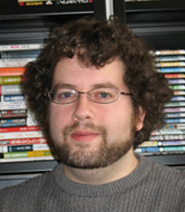Academics discuss Japanese pop culture
Concordia scholars from three different departments, and with disparate academic backgrounds, are joining forces at a daylong symposium on the Japanese media mix at this year’s edition of the university’s President’s Conference Series, February 4 to 6.
Film Studies professor Marc Steinberg, Communication Studies professor Mia Consalvo and History professor Matthew Penney will join a number of renowned scholars from the United States, Japan and Canada during the main component of the three-day event entitled Experiencing the Media Mix: Anime, Manga, Video Games.

The conference opens on February 4 with a keynote lecture by acclaimed scholar and manga writer Eiji Otsuka on The Unholy Alliance of Disney and Eisenstein: The Wartime Origins of Manga, Animation and Otaku Culture. A one-day symposium February 5 features four panel presentations followed by an interactive game arcade experience called Mixcade. These events are open to the public and there is no admission. A master class will be held on February 6.
Marc Steinberg
After acquiring an interest in Japanese media culture while completing his undergraduate studies at McGill University in East Asian Studies, Marc Steinberg began to study famous Japanese artists who draw on the aesthetics of manga (Japanese comics) and anime (Japanese animation).

“Their interests sparked my interests in a way,” he says. “What is it that they’re seeing in this that’s interesting, and how do we grapple with it?”
For his MA, which he also completed at McGill, Steinberg focused his attention on one Japanese artist in particular, Takashi Murakami, who is a pop icon in Japan.
Murakami is often compared to Andy Warhol, due to the shameless merchandising that is part and parcel of his art. “He wanted to do what Warhol did in the 1960s,” says Steinberg. “He wanted to make a character that could sell goods, and make paintings about this character.”
For his PhD thesis, Steinberg continued studying the use of characters to sell merchandise. The book based on his doctoral research, Anime’s Media Mix: Franchising Toys and Characters in Japan, is due out this March.
“The book really tracks the beginnings of character merchandising in the 1960s and moving to the contemporary period,” Steinberg explains, adding that character merchandising and its use of different media platforms is what led to the current form of the Japanese media mix.
During the one-day symposium February 5, Steinberg will speak about the media mix in its current form, and how it “requires us to rethink experience as an inherently cross-platform, multisensory example.”
Matthew Penney
Concordia History professor Matthew Penney admits that when he was an undergraduate, his worldview was western-centric — “filtered through our often-skewed mass media.”
But everything changed when he began watching more challenging films, such as Kurosawa’s Seven Samurai, and anime classics Nausicaa, Valley of the Wind and Barefoot Gen, which depicts the bombing of Hiroshima. “I had never been exposed to bombing from the point of view of victims, and as a first-year history student, this led me to start thinking about the past in different ways.”

Before graduating, Penney sat through the nine-hour, three-part epic Japanese war film, The Human Condition. “It is an expansive look at the brutality of militarism and imperialism, and it was my major inspiration to start research on anti-war themes in Japanese popular culture,” he says.
He spent two years studying in Japan, learning the language and absorbing as much of the country’s culture and history as possible. He travelled through all 40 prefectures, and developed a nuanced perspective of the country. “Seeing Japan as a normal life space, where people have very diverse backgrounds and desires, gave me a new foundation for thinking about Japanese history,” he says.
Many Japanese manga wrestle with the country’s difficult and violent imperialist past, in the same way as movies like The Human Condition. For Penney, these popular representations serve as vital secondary material. “I think of pop culture as one of the best ways that we have to build knowledge of and respect for other people.”
During his presentation, entitled Media Mixed Histories: Kyara versus Context, Penney will discuss examples of manga adaptations of popular history texts. Some of these texts, written by Marxists in the 1960s, sold millions of copies.
“They effectively brought the sorts of counter points to banal official versions of history that the government was propagating into the mainstream,” says Penney. “In the last 20 years, there have been new manga versions of this history. I am interested in how politicized history writing makes the transition to graphic novel form.”
The use of historical elements taken from texts, archives and even museum exhibits in manga fascinates Penney because it provides a context in which characters can wrestle with popular conceptions of institutions, such as the police, the army, and the government. “They shape the historical awareness of audiences in important ways.”
In the same way, though, historical artifacts taken out of context by manga writers, such as Nazi SS men recast as young girls in bikinis, can blur our understanding of historical events.
Nevertheless, Penney insists, “If I’m going to talk about ways that popular media can enrich critical historical writing, I also need to look at ways that it can trivialize the most serious historical experiences.”
Mia Consalvo
Communication Studies professor Mia Consalvo couldn’t have timed her arrival at Concordia much better. Just as she is finishing her research for a book about Japan’s influence on the video game industry and gaming culture, Concordia is hosting a conference discussing the country’s media mix and popular culture.

“I was happy to be invited to take part,” she says. “I think it’s going to be a really fun event.”
Soon after video game hackers figured out how to crack open old games and post them on the Internet, they began translating Japanese games that were unavailable to western players. Consalvo’s presentation during the one-day symposium will focus on these so-called ROM hackers and their translations of Japanese video games.
“I had done a previous project interviewing western game players who were interested in Japanese games,” she explains. “Because they enjoyed the games, they became really interested in Japanese culture. They started to learn the language, and they became interested in visiting the country. Then I learned about the fan translation projects that were going on, and so it became the next thing for me to study.”
Due to the increasing complexity of video games nowadays, it’s not enough for the hackers to simply translate the games verbatim into English. They have to adapt cultural nuances that come up in the game for a western audience.
“Translators will argue about things like humour,” Consalvo says. “They’ll say you don’t want to do a literal translation, because if I translate this joke that’s in Japanese, that references their popular culture, nobody will get it. So they ask themselves, how do I change it to make it still funny while capturing the essence of the joke?”
In the process of translating a game, ROM hackers may also change it to suit their audience. In other words, they may shorten it by removing levels. “Translators are interested in preserving the general story and flavor of a game, and making it available,” Consalvo says. “Early games are very grind heavy. You have to fight a lot of monster battles in order to proceed with the story. They know that contemporary gamers may not have the patience to put in that many hours.”
Fan translations of games are normally released on the Internet as a patch. Players need to own the original Japanese game in order to apply the translation to it. Even though Consalvo says she’s never seen a patch for sale on the Internet, they are a violation of copyright, and as such, they exist in a legal gray area.
As Consalvo explains, by releasing translation patches, fans put pressure on game companies such as Nintendo to release western versions of popular Japanese games. “They’re trying to say to them, you have a market here, and we can prove this market by showing you how many people have used the patch.”
The direct interaction between fans of video games and the industry that provides them, the creation of new, translated, localized versions of games, show how fans can interact with games on many different levels beyond simply playing them. As Consalvo says in her abstract, “They can expand the history of games, rewrite histories, and transform cultures and expectations.”
Related links:
• “Experiencing the Media Mix” — NOW, January 10, 2012
• President’s Conference Series